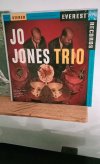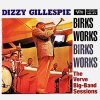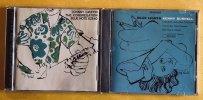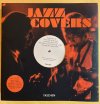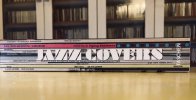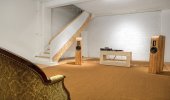Eric Hobsbawm was a British marxist historian. But pseudonymously in the fifties he was also Francis Newton a jazz critic for the New Statesman. In this very erudite and personal Diary he reminisces about the jazz scene of the time , the camaraderie that he built up with other jazz lovers from all over, anecdotal nuggets from back in the day and his own personal critique of the jazz of cats like Monk. Very interesting perspective from a person who for a decade or so inhabited that liminal zone occupied by the non-musician lover of jazz .
I owe my years as a jazz reporter to John Osborne’s Look Back in Anger, which made the British cultural establishment of the mid-1950s take notice of a music so evidently dear to the new and talented Angry Young Men. When, needing some money, I saw that Kingsley Amis wrote in the Observer on a subject about which he obviously knew no more and possibly less than I did, I called a friend at the New Statesman. He arranged a meeting with the editor, Kingsley Martin, then at the peak of his glory, who said ‘Why not?’, explained that he conceived his typical reader as a male civil servant in his forties, and passed me on to the commander of the (cultural) back half of the mag, the formidable Janet Adam Smith. Her interests ranged from mountaineering to poetry, but did not include jazz. As ‘Francis Newton’ (named after a Communist jazz trumpeter who played on Billie Holiday’s ‘Strange Fruit’), I wrote a column every month or so for the New Statesman for about ten years.
It was a good time to be writing about jazz. Not only did my column allow me an occasional respite from the personal and political convulsions of 1956, that year of Communist crisis, but it was the first time since 1935 that American jazz musicians could be heard live in Britain. Until then the typical British jazz fan, well informed by Melody Maker and tiny argumentative journals, had lived essentially on a diet of 78 rpm records, passionately analysed by young men in upstairs rooms or in the ‘rhythm clubs’ of the 1930s. A surprising number of these records had been made in the US for the British market, but hard-core aficionados, especially the small but missionary group of blues enthusiasts, also established their own networks for importing American discs. I had been on the fringes of this community of experts since the early 1930s, thanks to my cousin Denis Preston, who eventually became a pioneering figure on the recording scene; but, until the example of Kingsley Amis gave me courage, I had been too awed to join in their debates. Young and on the whole provincial, suburban and musically untaught, they were loving and propagandist critics rather than practitioners.
By the time Francis Newton was born, these aficionados had created a uniquely original youthful British pop scene in ‘trad jazz’, which reproduced versions of New Orleans jazz and country blues, by then far better known in this country than in the US. In one of my earliest columns I observed the sudden profitability of trad jazz ‘and even that last refuge of bankruptcy, blues-singing’, as illustrated by profitable but unimpressive imitations of Bessie Smith’s ‘Reckless Blues’ and a chart-topping version of Huddie Ledbetter’s jailhouse ‘Rock Island Line’, sung by a surprised and blameless British guitarist, Lonnie Donegan. What did it mean? I asked. We now know that it meant the rise of the British rock scene, the Beatles and the Rolling Stones, about to transform the American pop industry in the early 1960s. It never captured my generation, nor that of most jazz musicians, least of all the highly professional record studio session players who had to turn its illiterate amateur products into music.
But what did being Francis Newton mean to me? The attraction was not so much the opportunity to review jazz performances and the records now flooding in, or even to fit this extraordinary music into 20th-century society. It was the chance to understand the musicians and their world: in short, ‘the jazz scene’. I lived on the edge of the West End, and teaching at Birkbeck left most of the day free, so it was possible to combine my profession with the nocturnal and late-rising habits of the scene. My main base was the Downbeat Club on Old Compton Street, a few minutes’ walk from home, a joint which, like so many of London’s modern musicians and their hangers-on, I used as an off-duty reporting point. Though people might play there and it sometimes booked a pianist, the Downbeat was a social club, unlike Ronnie Scott’s new enterprise, then starting up in a not yet orientalised Lisle Street, where one went not to drink and gossip but to listen. There were also some after-hours joints in Soho where one could do both. Clubs are what I remember more vividly than the concerts in which visiting musicians earned their keep, though it was only in the US that I was to discover the glory of a jazz scene based primarily on clubs. I must have been one of the last to hear the great Ellington band, visibly at ease in its natural environment, play a genuine club date, ‘melting’, as I reported, ‘a hard assembly of middle-aged San Francisco lawyers, doctors, journalists and fixers like traditional brides’. I suppose this and meeting the tragic pianist Bud Powell in his Paris hotel room, catatonic except when at the keyboard, are the most vivid memories of my jazz years.
It soon became obvious that there was a notable gap both in taste and context between those of us – most jazz writers, but also successful players – who developed an enthusiasm for the music in the 1930s and 1940s, and the small corps of serious professional British musicians who played and formed the only real public for ‘modern’ jazz before Miles Davis began to make his impact. Writing about jazz in the 1950s meant, basically, trying to understand or at least come to terms with bebop (even the passionate jazz-conservative Philip Larkin eventually felt he had to make a gesture in this direction), but I don’t know how far I succeeded, except for an admiration for Thelonious Monk and an immediate passion for the supremely talented and intelligent Dizzy Gillespie, the most dazzling trumpeter in the world, who lacked no gift except the willingness to reveal his soul, as Parker had done. My admiration for Miles Davis was based on his records, not on any live performance I heard.
I enjoyed the company of the players, and they accepted me as an oddity on the scene (no milieu is more tolerant than that of jazz musicians), sometimes as the sort of walking reference book who could answer (non-musical) queries. I remember one from a tenor player’s girlfriend, about whether it was right to believe in God. But could any non-musician understand what creative musicians are really about, however much he socialised with them? After all, as one of them told me (I think it was the tenor saxophonist Sonny Stitt), ‘words are not my instrument.’ For a white non-musician to get close to black artists was even harder. Until the great exodus of American players in the 1960s, when the US jazz scene collapsed, few of them lived in Europe. True, there didn’t seem to be any difference between white and black in the Downbeat Club, and the young Cleo Laine was perfectly at ease describing herself as ‘a Cockney spade’, but visiting African-American players were aware of race even in tolerant Europe, and so, almost certainly, were British West Indians like the gifted and adventurous alto player Joe Harriott, who was an important component of the modern scene. Still, on the road, which was their permanent way of life, the Americans were used to being asked questions by white admirers, and experienced performers who relied entirely on the white circuit, notably blues singers, had a genuinely informative narrative ready.
As the only academic writing on jazz, and under culturally high-class auspices, Francis Newton naturally found himself acting as tourist guide to swinging Soho for foreign intellectuals. He also found himself drawn into the avant-garde cultural bohème in Britain, which overlapped with the non-bop jazz scene; George Melly and ‘Trog’ (Wally Fawkes, the clarinettist of the Humphrey Lyttelton school) were already producing their satirical and socially perceptive comic strip Flook in, of all places, the Daily Mail. I still have the membership card for Muriel’s Colony Club in Dean Street, which someone – most likely Colin MacInnes – pressed on me, but alcoholic camp was not my scene, nor jazz theirs, even though at one time they had decent background music played by an agreeable West Indian pianist. I was commissioned almost immediately to write a book. More to the point, being Francis Newton reinforced my contacts with those on whom the musicians depended, the agents, bookers and the rest of the pop music business world of which jazz formed a small corner. Their private opinions of ‘the talent’ diverged widely from their public ones.
I also found myself a member of the global network of intellectual jazz lovers. Since outside Britain these still saw themselves as something of an underground, if no longer persecuted, musical faith, they – and especially the writers – formed a surprisingly effective international of mutual trust and help. In the US this did not go as far as in Japan, where, as I was to discover in those tiny bars, the most formal academics – and who can be more formal than a Japanese university dean? – talked with an inconceivable degree of emotional frankness, simply because a guest they had never met before was a fellow jazz lover. I soon discovered that jazz solidarity, which went with the championing of Kafka as a first stage of the Prague Spring, was equally intense in Czechoslovakia. As the Miles Davis and Modern Jazz Quartet scores for Nouvelle Vague movies showed in the 1950s, French intellectuals were expected to be unusually hip about modern jazz but, as usual, took little note of non-French jazz writers.
Stateside, jazz solidarity was of more practical help. Local jazz writers did everything they could to help an unknown from London, from booking a hotel in Greenwich Village to passing him from one critic to the next for guidance to the scene in some unfamiliar city. It helped that so many promoters of jazz and blues came out of the left-wing milieu of the 1930s and 1940s, notably the greatest of all jazz talent scouts, the crew-cut John Hammond Jr, whose judgments were largely to guide my own.
It was only on my first trip to the US, where all surviving schools and artists could be heard at the same time, that I came to realise how lucky Francis Newton had been: this was a golden age for jazz, largely because even the ultra-boppers of the 1940s had rejoined and renewed the music’s mainstream. It was only on my second trip in 1963 that I realised how quickly the tsunami of rock music had swept it away. Birdland had put up the shutters. For the best part of the next 20 years, jazz hardly existed for the young, except in the university milieu as a part of adult high culture – like classical music, only smaller. What public did remain for live performance was antagonised by the emergence of a new, musically radical ‘free form’ jazz. Paradoxically, this isolated what was politically the most radical and racially militant movement in jazz from its natural African-American constituency.
By this time my life was changing. My wife, Marlene, claims that I proposed at a Bob Dylan concert. Marriage and babies inevitably put an end to Francis Newton’s freewheeling nocturnal lifestyle, though not to reviewing concerts and records. It wasn’t as much fun, except for the stunning and disturbing first visit to Britain of Ray Charles, whom I had first heard as one of a handful of whites in a corner of a vast rock-and-roll dance in Oakland, California, when he was still known only to the black public. They did not dance much while he sang. By now not quite a major pop star but already a hipster saint, fourth in line to Lester Young, Billie Holiday and Charlie Parker, and certainly already a monstre sacré, he worked the audience in the Finsbury Park Astoria with his ‘sanctified’ bluesy voice in a style combining showbiz effects and soul-baring emotion. I still shiver at the memory of hearing that hunched, thin, unhappy blind man milk the audience with ‘once I was blind, but now I see.’ Let that, as well as my spectacular failure to recognise the potential of the Beatles (I never had any time for the Stones), stand as the last memory of Francis Newton’s years covering the scene for the readers of the New Statesman.


